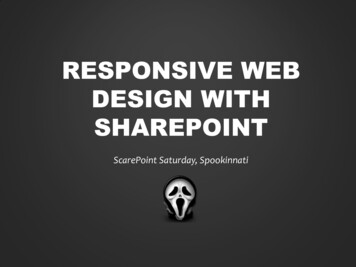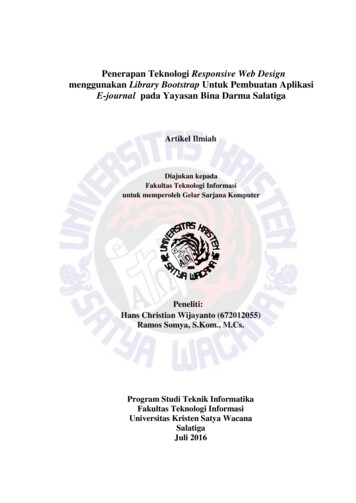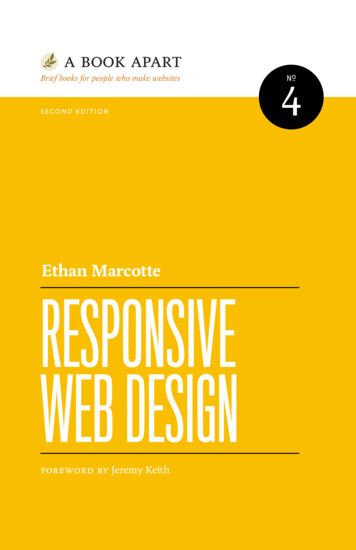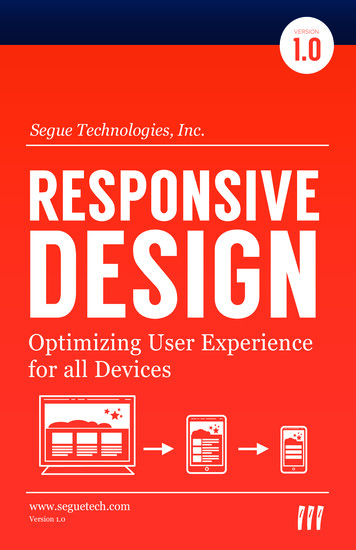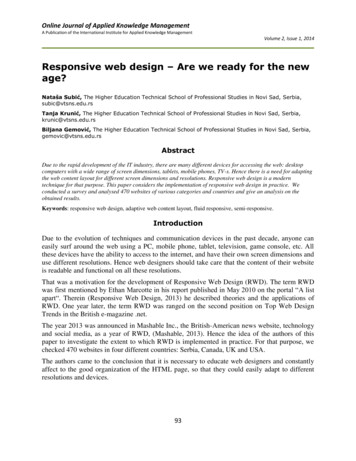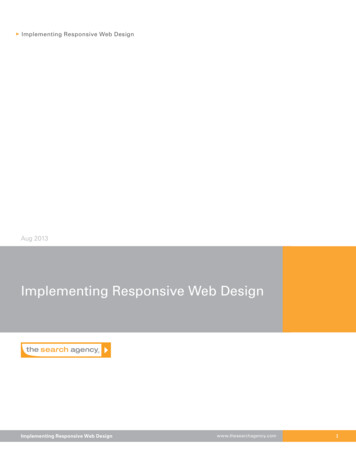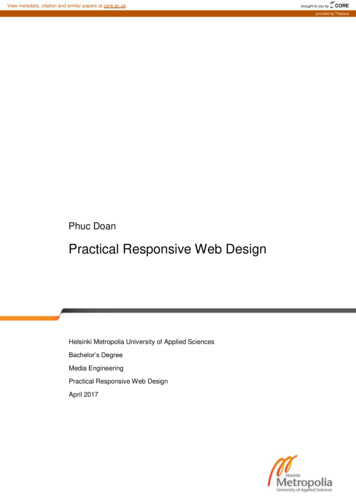
Transcription
View metadata, citation and similar papers at core.ac.ukbrought to you byCOREprovided by TheseusPhuc DoanPractical Responsive Web DesignHelsinki Metropolia University of Applied SciencesBachelor’s DegreeMedia EngineeringPractical Responsive Web DesignApril 2017
AbstractAuthor(s)TitleNumber of PagesDatePhuc DoanPractical responsive web design37 pagesApril 2017DegreeBachelor of EngineeringDegree ProgrammeMedia EngineeringSpecialisation optionMobile Application DevelopmentInstructor(s)Merja Bauters, Principal LecturerThe purpose of this study is to provide feasible information to designers and developers toimprove the process of building responsive websites. The study examines issues in webdesign and development projects and customers’ needs based on the data gathered fromthe market of handheld devices to elaborate key principles and patterns of responsive webdesign. Sample codes and illustrations are included in the thesis to demonstrate ideas andpractical techniques of each method that was used.Furthermore, two case studies are described as illustrative examples to show how thediscussed methods were applied in practice. The conclusion is that there are advancementsin the process of building responsive web pages to meet customers’ demands. In the end,there are always better approaches for improvement in Responsive Web Design as thesupported technologies are evolving constantly.KeywordsResponsive design, pattern, principles, mobile first, relative units
Contents1Introduction12Responsive Web Design23Principles and Patterns83.1Mobile First83.2Relative Unit and Media Query133.3Flexible images and videos183.4Navigation203.5Tools23Case Study274.1Finnair274.2Solu Machines3245ConclusionReferences3638
11IntroductionCurrently, in addition to desktop computers, there is an excessive number of handhelddevices such as mobiles and tablets that are used to get access the Internet. Thus,websites need to be responsive so they are viewable regardless the viewing device.Although Responsive Web Design is widely known as a feasible solution, the process todesign and develop a responsive web page has not been optimal. Designers anddevelopers are having difficulties in converting static web pages to flexible ones.Understanding this as a problem, this study is set to elaborate on key principles andpatterns that are commonly used to build responsive web pages. This study will focus onaspects that are identified as common problems while commencing web design projects.Having insights on these principles and patterns will serve as a strong starting point fordesigners and developers to build responsive web pages better and faster to meet thedemands of a customer.To show the readers how the key principles and patterns in Responsive Web Design areapplied practically, this study will include two case studies which describe the process toenhance the responsiveness in a realistic web design and development project.
22Responsive Web DesignIn this study, the goal is to show a reason why modern websites need to be responsive.An outline of the evolution of the characteristics of websites and the process of designinga website is given. The past is the basis for the present trend which is the responsiveweb design. Statistically, the usage of handheld devices and discussion of theadvancement of mobile devices are main reasons for the essentiality of responsivenessin web design. Besides, Cascading Style Sheets (CSS) has been one of the criticalforces constantly pushing the boundary of the World Wide Web. It has affectedresponsive web design directly. This section will include a short introduction to it.Even though the term World Wide Web was invented for over 20 years ago, it is stillconsidered as a new medium and the methodologies in web design keep changing andevolving continuously. Web design is a process of accumulating and arranging elementsto form a unified digital space where end-users not only can interact, but also absorb theinformation [1].Historically, web design started after NCSA Mosaic version 1.0 was publicly released in1993 due to its capability of showing images and text in the same place [2]. According toDavid Siegel, the first-generation websites are described as a straightforwardpresentation containing images and text and the different segments of the page werelikely to be displayed by bullet points and horizontal dividers [3]. However, due to thecommon 16 colours resolution used at the time, the colour range in one website wasquite limited which lead to bleak appearance across the websites in this era. As a result,the first wave of websites presented information plainly without providing any specificinteractions with the audience.With the evolution of HTML through the extensions, which was implemented by Netscapein 1995, web designers and developers started to create innovative experiences for theaudience via the web [3]. Since the 32 colours resolution monitor greyish backgroundswere replaced by colourful images, the content was organized in a more mindful waywhich improved and encouraged interactions between the users and the web itself.Unlike descriptive texts used in the first-generation to provide the information ordinarily,this time illustrative metaphors were adapted to create easy understanding, resulting inbetter user experience.
3HTML was not alone able to enrich the experience on the web. It did not meet thedemands from people on controlling how the web documents looked. In order toovercome the constraints of HTML, people wrote HTML in a non-semantic way which isnot considered as a good practice. CSS came into the scene as the means for designersand developers to leverage the World Wide Web to a new ground. [4]The first draft of the CSS was called Cascading HTML style sheets. It was published byHåkon W Lie in 1994. Internet Explorer was the first browser to implement CSS in August1996. The core idea of CSS is to provide a web writer a tool to style the document. [4.]It allows people to change the size and the colour of the font or the background imageof a specific element within the web document. This is illustrated in listing 1.h1{font-color:#010101;font-size:12px;}div {Background-image: url(‘sky.jpg’);}Listing 1. Setting font colour and size for h1 tags in HTML and changing the background of thetag.CSS also has provided a mean to separate the stylistic information and the content ofthe web document, giving HTML back its semantic value, as it should be done [8]. As anexample, when building a 2-column layout without CSS, the table tag in HTML has tobe used to render the columns. This is a non-semantic way since the purpose of the tagis to build a data table. Fortunately, with CSS, users are handed various ways to achievethe goal without having to manipulate the original HTML structure. As listing 2 illustrates,the layout is constructed by building a table with one row and two columns. I table tr td First Column /td
4 td Second Column /td /tr table Listing 2. A basic 2-column layout using only HTMLIn contrast, in listing 3, the HTML is set up as elements that are in the semantical correcttags and the result of the layout is achieved in CSS separately by positioning them sideby side by setting “float” property./* HTML Structure*/ div id ”container” div id ”column-1” p First Column /p /div div id ”column-2” p Second Column /p /div /div /* CSS Style Set 50%;float:left}Listing 3. A basic 2-column layout using HTML for structural mark-up and CSS for positioning webelements.Basically, the process of building a website can be split into two phases: design anddevelopment. In the design phase, the visual style is defined using visual elementscrafted by the designers. After that, development team will start to work to translate thematerials from designers into HTML and CSS code and the result is a web documentthat users can access and interact through web browsers. Due to the fact that themajority of users in the 1990s were using desktop monitors to access the web, webpages were designed to be fitted only on one medium, with different screen sizes.
5Recently, mobile phones, especially smartphones, have been a fast-growing market andfrom the business perspective, having websites that are compatible with browsers usedon mobile devices brings numerous opportunities to expand the business and gain profit.The number of shipped laptops, notebooks and desktop computers has dropped belowshipped smartphones since the last quarter of 2010. In other words, people prefer mobiledevices to computer desktops when visiting web pages and using applications. Forinstance, in November 2010, it was stated that the amount of connections to web-basedemail sites had dropped by 6% and the connections to mobile email sites had increasedby 36%. Furthermore, large digital companies such as Paypal, Ebay and Google havealready reaped positive results from their operations through mobile channels. [5.]Initially, the trend began in 2006 when Apple introduced the first iPhone. It was the firstmobile device that allowed users to browse the web comfortably. Thus, according toAT&T, the mobile traffic data went up by 4932% between 2006 and 2009. Additionally,the faster the mobile network is, the bigger the amount of mobile data traffic is. Besides,the price of smartphones devices and mobile data plan are decreasing which allowspeople who cannot afford desktops or laptop computers to view the web via mobiledevices. Evidently, the sales of smartphones grew by 96% in 2010 compared to theprevious year. [5.]The mobile devices are not only cheaper, but they also evolve rapidly. This has openedmultiple gates for designers and developers for building different kinds of services for theusers of mobile devices. For instance, smartphones support multi-touch gesturetechnology. Multi-touch means that users use multiple fingers to perform different actionson the devices. New patterns in interactions besides single-touch action has beeninvented so that the experience of using mobile applications has become more intuitive.For example, the “zoom” action can now be performed by moving two fingerssimultaneously in opposite direction, and the action “zoom in” and “zoom out” are definedby the relative distance between the two fingers. As a result, instead of using commonperipheral devices (mouse and keyboards) to tap the control elements on a graphicaluser-interface, users now perform zoom action as a natural interaction that is suitable formobile experience. A mobile device’s location is detected natively and designers anddevelopers can access information from a browser’s API to provide relevant informationbased on the user’s location. [5.] In fact, location detection has been implemented to
6smart search features on the web so a website will filter the result related to the user’scurrent location.Figure 1. Collection of devices and screen dimensions. Data gathered from Responsive WebDesign [6,144].Figure 1 presents different screen sizes that are widely available in the market. Thecurrent set of handheld devices also has a wide range of screen dimensions. Thus,building web pages the contents of which will be accessible and consistent acrossdifferent devices is critical for success. Businesses that rely on web documents that aredesigned and developed to be static will properly be crippled as customers are not ableto view their website properly on their device. To deal with the uncertainties among thehardware landscape and to deliver a coherent experience to the users, responsive webdesign is the solution. [6.]Responsive Web Design is a mastery to the make one website adapt to all screendimension of devices [6]. Before Responsive Web Design was considered as a trendycontemporary solution in web development, there were two common solutions for thedifferences of the devices. The first solution was to build different versions of one webpage for each specific device. For example, besides creating the version of a desktopcomputer, developers also built separate web pages that were only available for mobileand tablet viewers. This solution relied heavily on a technique named User AgentSniffing. The users are provided the webpages based on the device they are using. Theserver knows which version should be delivered based on the information retrieved fromthe users. The retrieved information reveals what kind of device and which browser arein use in the client’s side. This method proved to be unreliable in some cases becauseuser agent information can/could be modified by the user’s browsers and networks.
7[7,48.] The second solution is to build a native application to represent the sameinformation appropriately on each device. The advantage of native applications is theircapabilities to utilize hardware services which mobile web browsers usually do not haveaccess to. However, both solutions have identical disadvantages in increasing the costof production for building different versions and using different programming languages.[1.] As the client-side technology like HTML, CSS and Javascript have been evolving, itgrants developers and designers better tools to access the native services and to detectthe dynamic environment of the web browsers. As a result, responsive web design hasbecome more approachable.Even though people understand the benefits and motivations of Responsive Web Designfor modern web development, to enhance the flexibility of the web documents, designersand developers should be prepared and update their skillsets since the landscape of theWorld Wide Web changes constantly. In the next section, I identify and discuss criticalprinciples and patterns in Responsive Web Design that are utilized in web developmentin general.
83Principles and PatternsDesigning and developing web documents responsively is a holistic solution which allowsflexibility of the web pages. Furthermore, Responsive Web Design opens opportunitiesfor designers and developers to revise their workflow for delivering better userexperiences. This section will analyse key principles and patterns which are usedcommonly in Responsive Web Design.3.1Mobile FirstThe mobile market is exploding, meaning people have many options to choose from andnew devices are released regularly with better hardware and cheaper price. It is reportedthat there were approximately 7.9 billion mobile devices in the world in 2015. The majorityof devices are smartphones. The increase of smartphones was half a billion from 2014to 2015. Hence, Luke Wroblewski put forward a new design paradigm called “mobilefirst”. It is suggested that mobile experiences should not be considered as an alternatesolution in a web design project but rather be designed and developed as a primary focusfrom the beginning of a web design project. The purpose of this paradigm is to takeadvantage of the excessive growth in the market of handheld devices. [5.]Since mobile devices have their own characteristics compared to desktop computers,designing web pages for mobile experiences requires the developer and the designer tore-evaluate the approaches in building the web pages. Firstly, one of the most noticeabledistinctions between desktop computers and mobile devices is screen size. The spacefor contents in mobile devices has been cut down approximately 80% compared todesktop computers as the common dimension of a desktop is 1024x758 pixels and theresolution of popular smartphones is 320x480 pixels. Due to the limitation in space, thefunctionalities of web pages should be selective. Designers and developers need to knowwhat the customers’ and businesses’ needs are for the website. This is the key solutionto determine what the critical features are that should be available and what should beprioritized in the web page as the mobile environment does not have enough rooms forirrelevant details. Therefore, the core services of the web pages are focused and definedunambiguously from the beginning and when scaling the web pages to other devices,the core services remain the same which allows customers to have equal experiencesno matter what devices they are using to view the web pages. [5.]
9Figure 2. Bundling multiple graphical assets into one file to reduce the amount of request sendingto the client’s browsers. Data gathered from Mobile First [5,73].Secondly, even though mobile networks can be accessed from nearly anywhere, theirspeed is not considered to be as fast as the Internet connections people use on desktopcomputers. The mobile network is more expensive than the desktop network. Considerthis constraint, the experiences provided to customers using mobile devices have to beoptimized. Specific methods should be taken into account during the development anddesign process in order to increase the performance of the web pages. As figure 2shows, a number of HTTP requests sent to customers’ mobile devices are reduced sincemultiple images are bundled into one image. As listing 4 illustrates, the usage of CSS3properties is provided in case the web pages are accessed from old browsers. CSS3 isavailable natively within modern browsers to reduce the needs of using images, whichserve the same purposes and which, in some cases, are a fall back. [5.]/* Adding rounded corners */#element-1{border - radius: 4px 4px 4px 4px;}/*Adding gradient background */#element-2 {background: #ED4264; /* fallback for old browsers */background: linear-gradient(to left, #ED4264 , #FFEDBC)}/*Adding box shadow */#element-3{
10box-shadow:0 4px 8px 0 rgba(0,0,0,0.2)}Listing 4. Using CSS3 properties to add rounded corners, gradient background and box shadowsto HTML elements.The benefit of optimizing a web page’s performance on mobile devices upfront is thatdevelopers and designers do not have to worry about performance issues whentranslating the design beyond mobile devices.The interactions are considered as a bridge when connecting the users to the product.Crafting proper interactions on the web page helps delivering successful experiences.As it is stated above, the nature of mobile devices is different from desktop computersso usage patterns that are employed to design interactions for desktop computers shouldnot be applied directly to mobile devices. Foremost, the mouse and keyboard are theprimary means for users to interact with the web; however, as devices become smaller,“touch” becomes the way to input actions. Even though track pads and keyboards areavailable on some mobile devices, the number of users preferring touch-basedinteractions has been increasing gradually, as figure 3 shows. [5, 68]Figure 3. Transition to touch-based devices on Nokia smartphones. Reprinted from Mobile First(2011) [5,68].Naturally, the human fingers are less precise compared to a pixel-based pointercontrolled through the mouse [1]. As the screen sizes are smaller on the mobile devices,the area of the touch target is larger in order to reduce inaccuracies within the interactionbetween users and web documents. Therefore, the usability is assured when theminimum height of the touch target is 48 pixels in a 72 ppi screen as it is illustrated in
11figure 4 [9]. On the other hand, the touch target area should always be larger than theoriginal area of the button.Figure 4. Metrics for designing a button on mobile devices. Data gathered from Material Design[8].Since the ergonomics of webpage system has changed from desktop to mobile,organizing web elements on the screen has to be re-evaluated to maximize usability forall users across multiple devices. Statistically, 10-30% of people are left-handed and itis observed regularly that mobile devices are used in one hand and that the right thumbfinger is used to interact with the device [5]. Therefore, a critical call-to-action should beplaced either in the bottom or centre of the screen as it is showed in figure 5 so userswould take less efforts to complete the action.
12Figure 5. Comfortable areas while using smartphone. Modified from Mobile First (2011) [5,73].“Hover” is a common event on desktop interface when the user’s cursor moves over aspecific element on the web. Following that, an action will be triggered to providefeedback to users. For example, as it is illustrated in Figure 6 additional information willbe revealed when users hover on top of an image on the web. However, on handhelddevices, especially touch-based devices like iPhone and iPad, the hover action isobsolete since there is no cursor to use. Therefore, the purpose behind all hover actionsthat are used on the desktop has to be redefined when designing for mobile devices.There are three common alternative solutions to this problem and the they are appliedbased on the value of the content in a specific context. Firstly, if the triggered eventshows primary actions or relevant information to users, these actions and informationshould be place directly on the page. Secondly, if the hovered information is consideredas an expansion, a separate screen should be created. Lastly, if the value of the hovereffect is inconceivable, it is strongly recommended to let it go in order to reduce thecomplexity the page’s user interface. [5.]
13Figure 6. Default and hover state of an element. Data gathered from Mobile First [5,79].3.2Relative Unit and Media QueryCSS has been used to set the styles for all the elements on the web, and new featureshave been still implemented to enhance the responsiveness to the web pages.Therefore, this section will discuss in detail the usage of the common CSS features whichare practical in Responsive Web Design.Instead of using fixed typed values for measurements in CSS, relative units areconsidered more relevant since all elements on the web pages are usually required tobe scalable.Table 1. Common absolute units and relative units in CSS. Data gathered from Mozilla DeveloperNetwork [9].NameTypeDescriptionPixel (px)Absolute unit1 pixel 1 pointPoint (pt)Absolute unit1 point 1/72 inchInch (in)Absolute unit1 in 2.54 centimetresEmRelative unitRelative to the font-size of the elementremRelative unitRelative to the font-size of the root elementwhich is the html in this case
14As it is illustrated in table 1, Pixel (px) is one of the most popular measurement units thatis used in CSS. However, the webpages nowadays are viewed on various types ofdevices so building web components that rely on static units as pixel is not consideredpractical. Thus, it is recommended to translate absolute values to relative values in orderto maintain the proper proportion of the web element when the webpages are viewed onmultiple devices. For instance, in the example listing 5 gives, the goal is to create a twocolumns layout, so instead of defining the width of each column in pixels, it is practicalto use percentage (%) for preserving the proper proportion between the two componentsregardless the devices they are being viewed on./* Setting absolute value */div#sidebar {width: 320px;}div#content{width: 768px;}/* Using relative values */div#sidebar {width:30%;}div#content{width:70%;}Listing 5. Using relative unit to maintain the proper proportion of the components.In addition to the percentage, em and rem units are used to maintain the properproportion between the web elements. Em and rem are used for the web browsers todetermine the actual measurement of the web component in pixel. The rem unit iscalculated based on the default font-size of the root element which is an/the html tagand the default font-size value is 16 pixels. For instance, in order to express pixel unit inrem unit, the formula below is applied:Target / 16 Result (1)
15“Target” is the value in pixels and “Result” is the value in rem. As 24 / 16 1.5, the valuethat should be used in CSS is “1.5 rem”. The relative units em are calculated with thisformula:Target / Context Result (2)The meaning of the parameters “target” and “result” in (2) are the same as they are in(1). Instead of dividing the pixel-based value by 16, a new parameter “context” is definedby the font-size of the current element in the HTML structure. [4,21.] For instance, inlisting 6, since the font-size values of container-1 and container-2 are different so thevalue of the margin also expresses dissimilarity in em unit.#container-1{font-size: 16px;margin: 1.5 em; /* 24 / 16 1.5 */}#container-2{font-size: 18px;margin: 1.33333333 em; /* 24 / 18 1.33333333 */}Listing 6. Relative value in ems are varied depending on the font-size property of the container.Responsiveness in the web pages is leveraged by applying a media query in CSS as ananticipation to the variety of the devices that are used by the users. Responsiveness wasintroduced as media types which were introduced in CSS2 specification. Its goal is todifferentiate stylesheets based on different media and device types. For instance, inlisting 7, the generic.css is always loaded regardless the device or media it is on becausethe media attribute is set to “all” which is defined as a supergroup to all the parameters.In the following rows, there are three stylesheets and each one is assigned to a specificmedia or device so when the page is accessed from a screen-based device, the pageonly loads the file screen.css and ignores the rest. link rel ”stylesheet” href ”generic.css” media ”all”/
16 link rel ”stylesheet” href ”screen.css”media ”screen” / link rel ”stylesheet” href ”mobile.css”media ”handheld” / link rel ”stylesheet” href ”print.css” media ”print”/ Listing 7. Using different stylesheets based on media type.Alternatively, multiple stylesheets can also be incorporated into one CSS file to reducethe number of requests sent to the server. It is done by using @media statement in CSSas it is demonstrated in listing 8.@media all {/* Define your stylesheet here*/}@media screen{/* Define your stylesheet here*/}@media print {/* Define your stylesheet here*/}Listing 8. Using @media to implement multiple stylesheets into one CSS file.However, due to the advancement of mobile devices, the “handheld” value in the mediaattribute cannot detect all the browsers on the modern mobile devices and almost allmobile web browsers are treated as screen-based media. Thus, using only media typesin media query could not fulfil the goal of enhancing responsiveness to the web pages.[6,73-74.] Fortunately, media queries were introduced as an extension to media type inthe CSS3 specification to solve the problem. In addition to identifying what kind of media,relevant properties of the web browsers and devices can be also examined by using themedia query in CSS.
17@media screen and (min-width: 1024px) {/* Define your stylesheet here*/}Listing 9. An example of using media query in CSSAs it is illustrated in listing 9, the structure of a media query statement includes two parts:@media screen which is already explained above, and (min-width:1024px) which isdefined to inspect the width of the browser that the web is rendered on. In short, thestylesheet is applied when the media is screen-based and the width of the browser is atleast 1024 pixels. If the conditions are not fulfilled in the media query statement, thestylesheet within the query is simply ignored by the browser. Many features of the devicecan also be queried and they are described in table 2. As a result, a collective of a/thetarget device’s characteristics can be defined within one query which is considered as afeasible feature to enrich the responsiveness on the web pages [6].Table 2. A list of device features that are compatible with media queries. Modified fromResponsive Web Design (2011) [6,76].Feature nameDescriptionswidthThe width of the display areaheightThe height of the display areadevice-widthThe width of the device’s renderingsurfacedevice-heightThe height of the device’s orlandscape valueaspect-ratioRatio of the display area’s width overits heightdevice-aspect-Ratio of the device’s renderingratiosurface width over its heightUsing multiple media queries allows developers and designers to define differentbreakpoints, which ensures the integrities of the content when it is viewed on different
18devices. Additionally, the media query and the “mobile first” paradigm can be combinedin order to increase the responsiveness for web pages. As it is demonstrated in listing10, the stylesheets for the mobile scenarios are built as default in the CSS. As theresolution is increasing, media queries are used to define the characteristics of the layoutat different breakpoints. Thus, users who are using old browsers that do not supportmedia queries can also view the web pages./*Default layout */.section {margin: 0 auto;max-width: 700px;}/* Medium screen layout */@media screen and (max-width:991px){/*Custom stylesheets*/}/* Large screen layout */@media screen and (max-width: 1199px){/*Custom stylesheets*/}/* Extra large screen layout */@media screen and (min-width: 1200px){/*Custom stylesheets*/}Listing 10. Apply “mobile first” paradigm with media query3.3Flexible images and videosIn addition to text, images and video elements are also served as essential means toconvey a message from the pages to the users. As the web pages go responsive, videosand images have to be transformed from static to fluid in order to be compatible with theresponsiveness of the pages.One of the most common problems when dealing with images is that the size of an imageis not match with the size of the container which leads to a situation where the rendered
19image on the page is bigger or smaller than it is intended to be. Thus, setting max-widthto 100% for the image, as it is demonstrated in listing 11, is one of the fundamental thingsthat should be done to enhance the fluidity into the images on the web. Setting the maxwidth to 100% to images will prevent them from surpassing the containing element sincethe image’s width is a
2 Responsive Web Design In this study, the goal is to show a reason why modern websites need to be responsive. An outline of the evolution of the characteristics of websites and the process of designing a website is given. The past is the basis for the present trend which is the responsive web design.
